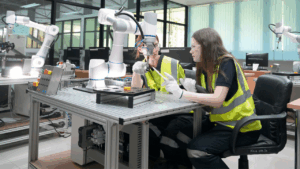The fashion industry is currently anything but sustainable. It’s estimated that the fashion industry as a whole contributes more to climate change than the aeronautical and shipping industries combined[1]. Without significant changes, and consumers switching to sustainable fashion, the industry could account for a quarter of the world’s carbon budget by 2050[2].
It’s not just environmental sustainability that’s lacking in the fashion industry, social sustainability is too. The events of the 2013 Rana Plaza disaster in Bangladesh which resulted in the deaths of over 1,100 garment workers,[3] is just one example of the problems within the fashion industry.
And, while many players in the fashion industry make huge profits, when bikinis are being sold for $1.75, the economic sustainability of fashion isn’t looking too good either. Surely something has to give?
At the beginning of this sustainability series, we looked into “what is sustainability?”, the fashion industry is just one area where there is huge room for improvement. In recent years, consumers and businesses have shown signs of change and the need for change was emphasized by supply chain issues during the pandemic[4].
In this post, we’ll look at what sustainable fashion is, the problems with it, and what we can do about it.
What is Sustainable Fashion?
Sustainable fashion is fashion that’s mindful of its social, environmental and economic factors. It’s fashion developed by companies that pay their workers a living wage, give them safe, healthy working conditions and monitors its environmental impact, taking care to use more sustainable materials and reduce resource use throughout their products’ life cycle.
Sometimes you may see sustainable fashion called “ethical fashion”, “eco-fashion”, “eco clothing” or even “conscious clothing”. These terms are interchangeable though those using “eco” typically have a stronger focus on the environmental issues of fashion, rather than the social factors. Sustainable fashion also relates to our actions as consumers, especially when it comes to our consumption patterns.
What’s the Problem with Fashion?
There are several issues with the fashion industry’s sustainability or lack of. Here, we’ll explore some of the environmental and social costs of fashion in more detail.
The Arrival of Fast Fashion
Many of the issues with fashion stem from the arrival of fast fashion.
Previously, the fashion industry was centred around two main seasons a year. Designers and fashion companies created collections for spring/summer and autumn/winter. Recently, this has changed, and the fashion industry can be seen to have 52 seasons a year as new garments appear in shops on a near-weekly basis.
This is known as fast fashion where trends change rapidly, and prices are often low drive by companies’ desire to keep selling.
While low prices may seem great, the cost of some garments has become unsustainably low. We’re at the point where it’s possible to buy items of clothing for under $10 and when prices that low, it’s simply not possible that the many people involved in making an item of clothing are being paid and treated fairly.
In the UK, the chair of the parliamentary environmental audit committee, which investigates the fashion industry said: “we don’t think the true cost is a £5 ($8.80) dress. That price is not being paid by us, it is being paid by someone else and the environment.[5]”
Fashion and Water
The fashion industry consumes a lot of water and causes water contamination.
High water consumption is particularly noticeable during an item’s manufacture and consumption continues to increase post-purchase due to clothes washing.
The UN estimates that a single pair of jeans uses 1kg of cotton taking 7,500-10,000 litres of water to grow. This equates to 10 years’ worth of drinking water for 7 people[6]. A cotton t-shirt, for example, takes 2,650 litres of water, or 27 bathtubs full of water[7]. On top of this, cotton is often grown in very dry countries and therefore draws on an already limited supply of water.
The fate of the Aral Sea is an example of fashion’s unsustainability when it comes to water. Once the fourth largest lake in the world, the Aral Sea on the border of Kazakhstan and Uzbekistan, began drying up in the 1960s when the area was developed for cotton making. By the 2010s, it had dried up completely. Though there were several factors for this, cotton production is often cited as one of the main causes[8].
The disappearance of the Aral Sea was a blow for the environment and those living near it. The exposure of the bottom of the lake released salts and pesticides into the atmosphere which poisoned both farmland and people. In addition, carcinogenic dust is blown into villages causing throat cancers and respiratory diseases[9]. Local fishermen and farmers who used to earn a living from the Aral Sea and the surrounding land were now unable to do so. Even when the cotton was growing, those harvesting it were forced into doing so[10].
In addition to the high-water consumption to grow fashion’s raw materials, water used in processing these materials, especially dying them, is high too.
The fashion industry is said to be responsible for 20% of global waste water[11] and pollution is high due to the use of fertilizers, pesticides, chemicals and dyes.
Fashion and energy emissions
Fashion production releases harmful emissions, including greenhouse gases (GHGs) such as CO2, throughout its life cycle (the stage of an item from the growth/extraction of raw materials to disposal/recycle).
Energy is used to grow or extract the materials, process them, transport them and wash, dry and iron them. Eventually, the clothes end up in landfill where they can take several hundred years to decompose releasing more CO2 in the process.
In 2015, emissions of GHGs from the fashion industry totalled 1.2 billion tons of CO2 equivalent; more than the emissions of all international flights and maritime shipping combined[12].
The global nature of the fashion industry means that clothes may have travelled across the world several times before they end up on the racks in your favourite shop. While the switch to online shopping has its benefits in terms of a reduction in emissions if you’re not driving to get to the shop, it has its own problems. Overordering during online shopping to avoid the inconvenience of clothes not fitting or the style not being right leads to doubling the emissions involved in buying an item when we return it.
The fashion industry’s chemical use
Harmful, chemicals used in the fashion industry are harmful to the people producing our clothes as well as our ecosystems. Factory workers and those working with raw materials are often the most vulnerable people in the supply chain and the most exposed to these harmful chemicals.
In one instance, a European textile-finishing company used over 466g of chemicals per kilogram of textile.[13] That’s almost the same amount of chemicals as textile!
There’s an interesting post here about some of the chemicals used in denim jeans.
Fashion and growing waste
The garments themselves add to the chemical, emissions and water waste connected to the fashion industry.
The rise of fast fashion and the pressure people feel to update their closets means we’re consuming more clothes than ever, and also throwing more away.
Between the years 2000 and 2018, the number of new garments produced per year doubled from 50 billion items to over 100 billion[14]. It’s estimated that 92 million tons of waste are created each year, the same as a garbage truck full of clothes arriving at landfills every second.[15]
While donating to thrift stores or dropping clothes at recycling centers can help, they’re not the ideal solution they seem.
In the production of low-cost fast fashion, corners are cut somewhere. One of these corners is in the quality of garments. By the time an item has been worn a few times, it may no longer be of useable quality and therefore not suitable for thrift stores or reselling.
Recycling isn’t a clear-cut solution either as many synthetic materials, such as the plastics used to make jeans stretchy, are almost hard to separate from the other materials making recycling virtually impossible.
The result of this is that donating or recycling excess clothes doesn’t often match up with our good intentions.
Fashion has become disposable and that is a major issue when it comes to sustainability.
Fashion’s Supply Chain Issues
The complex nature of fashion’s supply chain makes traceability hard.
Raw materials are grown in one place (or several depending on the final product), transported to other locations to be dyed, cut, stitched, and packaged, then distributed globally. Then there are the workers who design, stock, sell, and market the items.
The fashion industry involves many people, with some estimates saying 1 in 6 people work in some part of the global fashion industry (True Cost of Fashion documentary). The majority work in factories in developing countries that are paid very little and work in dangerous conditions.
The desire to maximize profits, often achieved by outsourcing production to countries such as Bangladesh which has cheap labour, makes monitoring environmental commitments difficult. Especially as environmental laws are often not as strict as those in more developed countries.
The Human Cost of Fashion
The above issues concentrated mostly on the environmental costs of fashion, but the human cost of fashion cannot be ignored.
The 2013 Rana Plaza collapse in Dhaka, Bangladesh is a striking example of the devastating human costs of the fashion industry.
When the factory collapsed, over 1,100 people died and a further 2,500 were injured. It was the deadliest disaster in the garment industry and came in the same year as two other devastating incidents[16]. Factory bosses had been warned of unsafe working conditions, but the demands placed n them by brands to produce clothing for less meant that little was done to fix the issues.
In factories such as the above, workers have tried to unionize and campaign for better, safer working conditions and pay (many earn just US$0.32 an hour)[17] but are often ignored or even met with violence (True Cost of Fashion documentary).
The human cost of fashion is one of the areas the biggest difference can be seen between fast fashion vs sustainable fashion.

How Can Fashion Become More Sustainable and What can you do?
The above paints a bleak picture but there is some positive news when it comes to the future of the fashion industry.
Studies suggest that the ‘buy less, buy better’ ideology of generation Z (those born between 1997 and 2015) could see the end of fast fashion and its unsustainable practices. In addition, a study carried out in 2020 showed that 28% of those polled, are recycling or reusing more clothes than normal and that 35% of women intend to buy fewer clothes in the future[18].
There’s a long way to go, but there are several small actions we can take to help make fashion more sustainable.
Buy less, wear more
Buying fewer clothes is one of the main things we can do to reduce the impact of fashion.
The issues with fashion are exacerbated due to an increase in production. If we all take steps to buy fewe new items, production will be forced to decrease to a more sustainable level and thus the emissions, waste and chemicals will reduce too.
Look into creating your own capsule wardrobe made up of a limited number of items that can be mixed and matched to created different outfits[19]. If you’re still someone who wants to keep their wardrobe stocked of new-to-you items, then look into thrift shopping in person and via apps such as DePop or Poshmark and clothes rental websites which offer sustainable ways to shop.
Choose Natural Materials with Fewer Dyes
Favouring natural materials, such as wool and linen, over synthetics is another way to reduce the negative impact of your wardrobe.
Lots of synthetics are made from plastics, which rerelease microplastics during washing and are almost impossible to recycle or take centuries to decompose[20].
Choosing clothes that are as close to their natural state as possible is another sustainable fashion choice. This means clothes that haven’t been subjected to bleaching, sandblasting (which gives denim a ‘worn’ look), heavy dyeing or lots of pre-washing.
Wash cooler and less often
When it comes to taking care of your clothes washing cooler and less often is key to improving your own fashion sustainability rating and you’ll save money on your electricity bill.
Laundry products now work effectively with cooler temperatures. Wash with full loads and spot clean items when necessary rather than giving them a full wash.
Shop sustainable clothing brands
Sometimes called ethical clothing companies, sustainable clothing companies are growing. These companies are generally more transparent about the resources used in the manufacturing process of their clothes, update their lines less frequently and pay their workers fair wages.
Though there’s a conversation around ‘greenwashing’ (giving a false impression of your products’ true sustainability), there are websites you can consult and certifications, such as Fair Trade clothing, to look for when you’re shopping for sustainable fashion brands.
The website, GoodOnYou rates fashion brands based on their environment and social commitments and company policies such as giving back to environmental charities or offering repair programs are good signs to look for.
Summary
The environmental and social impacts of fashion, and specifically fast fashion, are huge but the future of fashion and its chances of moving towards sustainability is looking brighter. Starting with small actions such as reducing your consumption of fashion will not only benefit you but has global benefits too.





